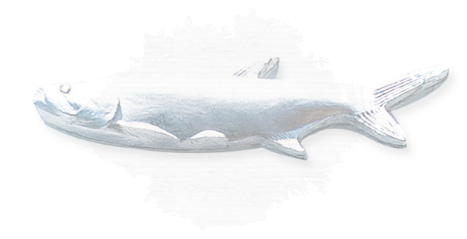Starfish or Sea Stars
What we once called a “starfish” now goes by the name “sea star” because, well, it’s not much of a fish, now is it?
There are over 2,000 species of sea stars on the planet today living in habitats that range from the warm shallow waters of coastal coral reefs to the deep, freezing-cold waters of the Antarctic.
These fascinating creatures are echinoderms, derived from the Greek word for “spiny” and the Latin word for “skin,” which include brittle stars, urchins, and sea cucumbers as well. Sea stars have been on Earth since the Ordovician Period, over 450 million years ago! They look remarkably similar to their ancient ancestors, and some consider them living fossils.

Sea Star Anatomy
Sea stars have an endoskeleton made of calcium carbonate bony plates called ossicles. These sit under skin and are held together by connective tissue, allowing for strength and flexibility. The ossicles give the skin texture, creating horns, spines, and bumps. Sea stars exhibit radial symmetry, meaning that if you drew an imaginary line through the center of the animal to fold it in half, the sides would match. The vast majority of sea stars have pentametric radial symmetry, with five arms that radiate from the central disk, which gives them their star-like shape. It is not uncommon to see some sea stars with four or six arms due to developmental abnormalities. Some species naturally have more arms — up to 40 or more! Most sea stars can lose and regenerate lost limbs and will even sacrifice an arm for defense.
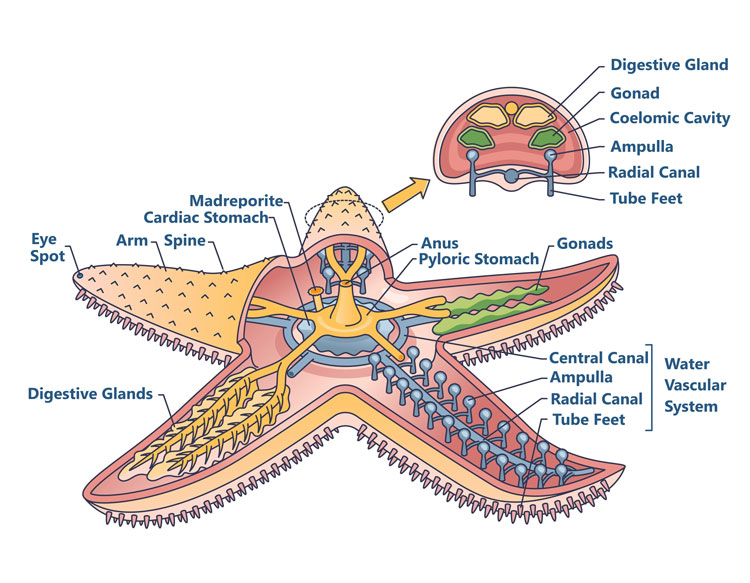
What Can Sea Stars Sense?
Sea stars don’t have a centralized brain, but they do have a neural network that allows them to sense and respond to light, chemical cues, touch, temperature, and position. Each arm has an eyespot at the tip, and there may be additional photoreceptors across the body. Even though they come in a rainbow of colors, sea stars do not have color vision. They will move toward or away from light, depending on the species and their habitat. Some are able to make out large immovable objects, like the structure of a reef, but the extent to which sea stars use vision for navigation and hunting is still under investigation. Their tube feet are sensitive to touch and chemical cues, especially the ones at the tips of the arms. This allows the sea star to sense the direction of food. A sensory nerve net in the epidermis (skin) of the sea star and a motor nerve net on the inside of the body are connected by neurons that exchange information. Given that sea stars don’t have a centralized brain, they are not able to make a plan of action. It is thought that if one arm receives strong sensory information, it becomes dominant and takes over, directing the movement of the animal.
How Do Sea Stars Breathe?
Sea stars don’t have any blood — they use water instead! Water enters the sea star through a special ossicle called the madreporite or sieve plate, which is then pumped through a series of canals throughout the body. Tiny finger-like projections on the body, called papulae, cover the skin. Oxygen diffuses across the thin membrane, passing into fluid in the coelomic cavity where it is moved throughout the body. Sea stars can’t breathe if there isn’t enough oxygen in the water around them, or if they are removed from the water. That is why a sea star should always be kept underwater.

How Do Sea Stars Move?
A water vascular system moves water around the body of the sea star where it is used for gas exchange, movement, and adhesion. This hydraulic system allows the sea star to move by pumping water in and out of hundreds of tube feet. These projections appear to have suction cups at the end, and it was once widely held that they acted much like the suckers of an octopus, creating mechanical force by reducing water pressure in the center of the disk. This notion has recently been challenged by new research using extremely powerful microscopes. It appears that a chemical, rather than mechanical, reaction on the surface of the tube foot makes it stick and then release.
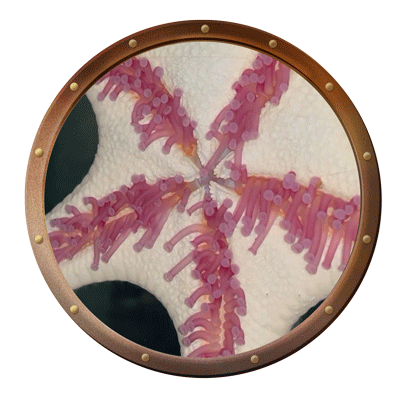
How Do Sea Stars Reproduce?
Sea stars have a lot of diversity in their reproductive strategies. Most are gonochoric, meaning there are both males and females, but some species are simultaneous hermaphrodites and make both eggs and sperm at the same time. Most sea stars reproduce through spawning; males and females release sperm and eggs into the water where they meet and develop into an embryo. Spawning may be triggered by chemical cues, such as pheromones released by the first individual, or environmental cues, such as the length of day or large changes in temperature. Fertilization occurs in the water column, and the larvae spend the first part of their lives as part of the plankton. If there is abundant food available and conditions are good, larvae may clone themselves through budding. They will end up spending extra time developing, but this results in more adults.
There are a few species that use a brooding strategy: the female either keeps the fertilized eggs inside her body or sits on top of them as they develop. This strategy is most commonly seen in species that live in very cold water that is inhospitable to larvae.
Asexual reproduction in sea stars is far less common than sexual reproduction. This may occur through fissiparity, splitting in half, or autotomy of arms, where an arm is shed and a new individual grows from it. Fissiparity is only known to occur in three genera (Coscinasterias, Stephanasterias, and Sclerasterias), while autotomy is even more rare, occurring most notably in the Linckia genus. These sea stars can be seen with limbs in various stages of development, sometimes as one large limb with small limbs growing from it. This gives them the common name “comet sea stars,” as they resemble a shooting star.

What Types of Sea Stars Are Most Common in the Florida Keys?
Conical Spined Sea Star, Echinaster sentus
Also called the Spiny Sea Star and Florida Common Sea Star, this species has coneshaped spines that are arranged in regular rows. The spines are typically red to orangish-brown with dark red to violet valleys between the rows and tufts of maroon to violet papulae. The tube feet of this species are orange. It is a shallow-water species found in seagrass beds, sand, and rubble-bottomed environments.
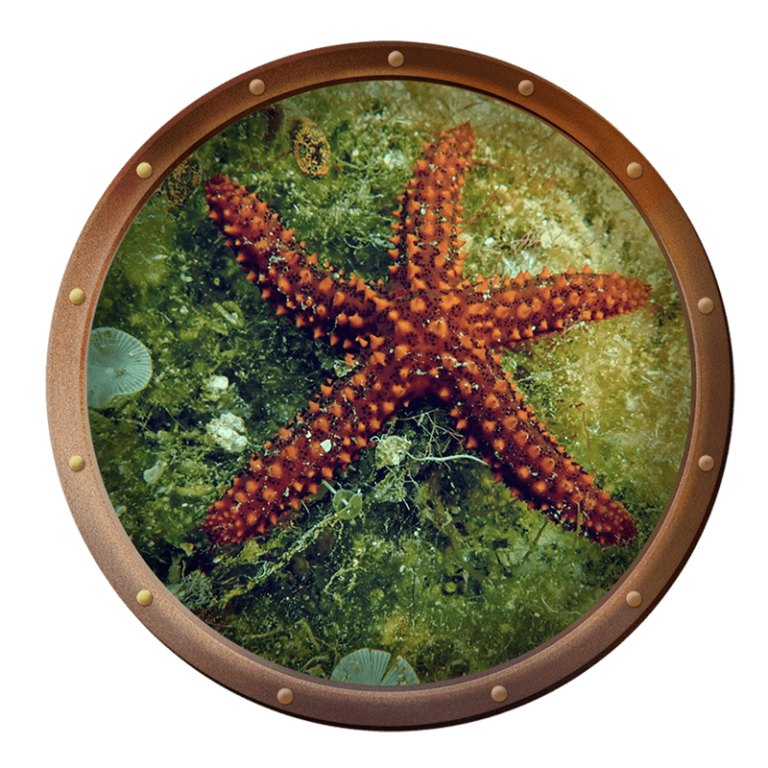
Small Spined, or Orange-Ridged Sea Star, Echinaster spinulosus
This species has irregularly spaced ridges of spines with whitish valleys in between. The spines are typically orange to orange-yellow. It can be found around structures like reefs and dock pilings as well as in sandy-bottomed habitats.

Bahama or Cushion Sea Star, Oreaster reticulatus
This is the largest sea star species in Florida and may come in a range of reds, yellows, oranges and browns as an adult. The juveniles tend to be more green and spend most of their time in seagrass beds. Bahama Sea Stars are omnivores and one of the few animals that eat sponges. They were overharvested as souvenirs and curios due to their impressive size, leading to a population collapse in the Keys. They are now a protected species in Florida, and no commercial or recreational harvesting is allowed. If you see one of these impressive sea stars in the wild, count yourself lucky and leave it where it is!

Nine-Armed Sea Star, Luidia senegalensis
Named for the nine arm rays that extend from the central disk, this species is typically buried in the sand. It is nocturnal and rare to see out in the daytime.

Banded Sea Star, Luidia alternata
The Banded Sea Star is named for the chevron-shaped dark bands that extend down its arms. These bands may vary in color, including reddish, brown, dark green or purple, and can be indistinct on some individuals. The edges of the arms are lined with fringing conical spines, and the tube feet are orange. This species is nocturnal and buries itself in mud and sandy bottoms.
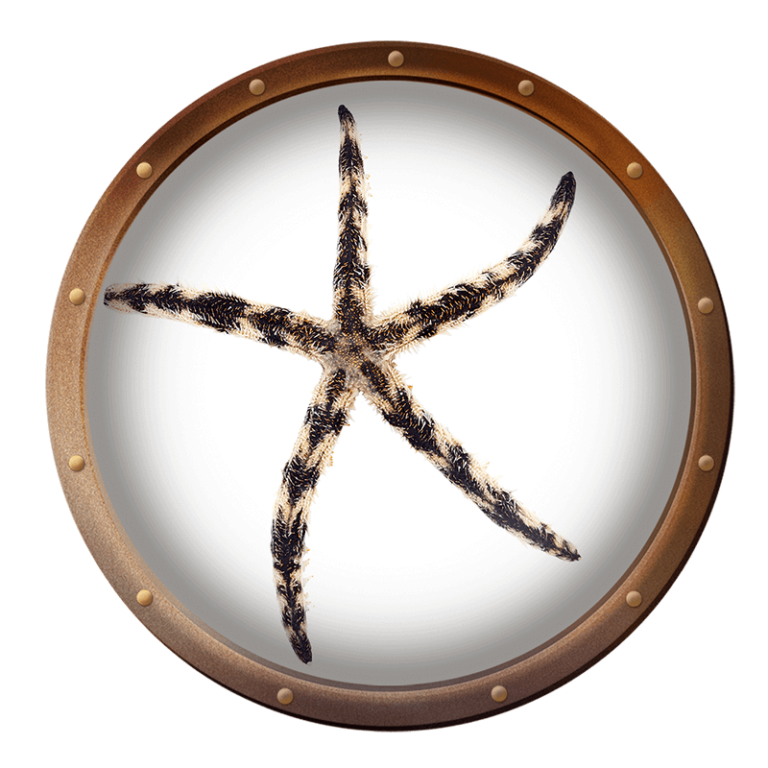
Lined Sea Star, Luidia clathrata
Named for the distinct stripe that extends down the arms from a central point in the disc, it is also called the Gray Sea Star for its typically light gray color. This species may come in lighter tones as well, with a yellow stripe extending down white arm rays.

What Sea Stars Are at the Key West Aquarium?
The Touch Tank has several Florida Common Sea Stars (Conical Spined Sea Stars), Echinaster sentus, that you can interact with! They showcase the variety of colors that this species comes in.
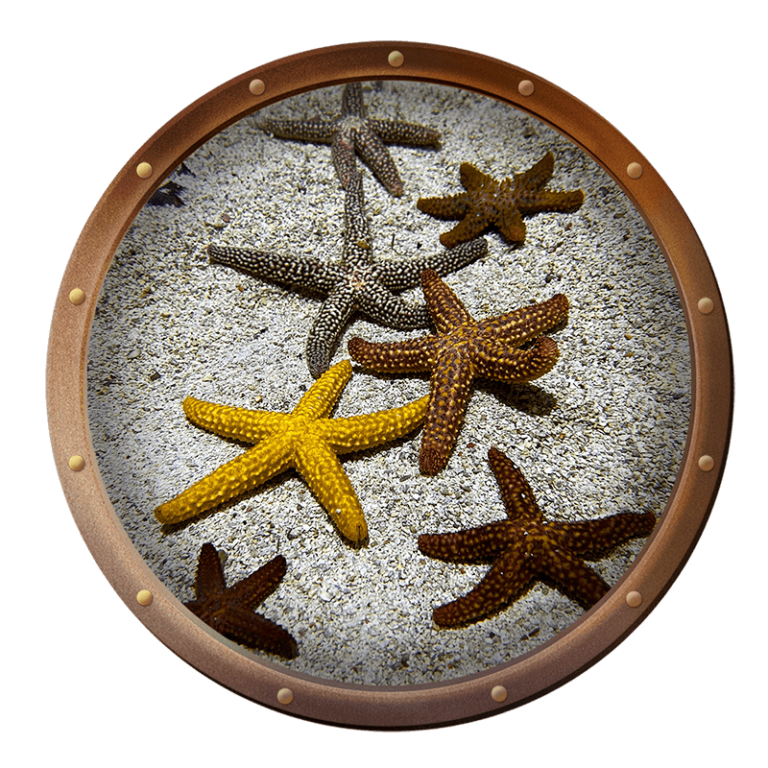
The “Lionfish” exhibit houses Chocolate Chip Sea Stars, Protoreaster nodosus. The common name of this species refers to the dark spines on top of the sea star that look like chocolate chips. It is also called the horned sea star, but that is not nearly as fun. The tube feet are pink/purple, and you can usually get a good view of them as they walk across the glass window of the exhibit. This species is not a Key West local — it is native to the Indo-Pacific like the invasive lionfish. They are commonly seen feeding in large groups over seagrass beds or sandy-bottomed habitats.



